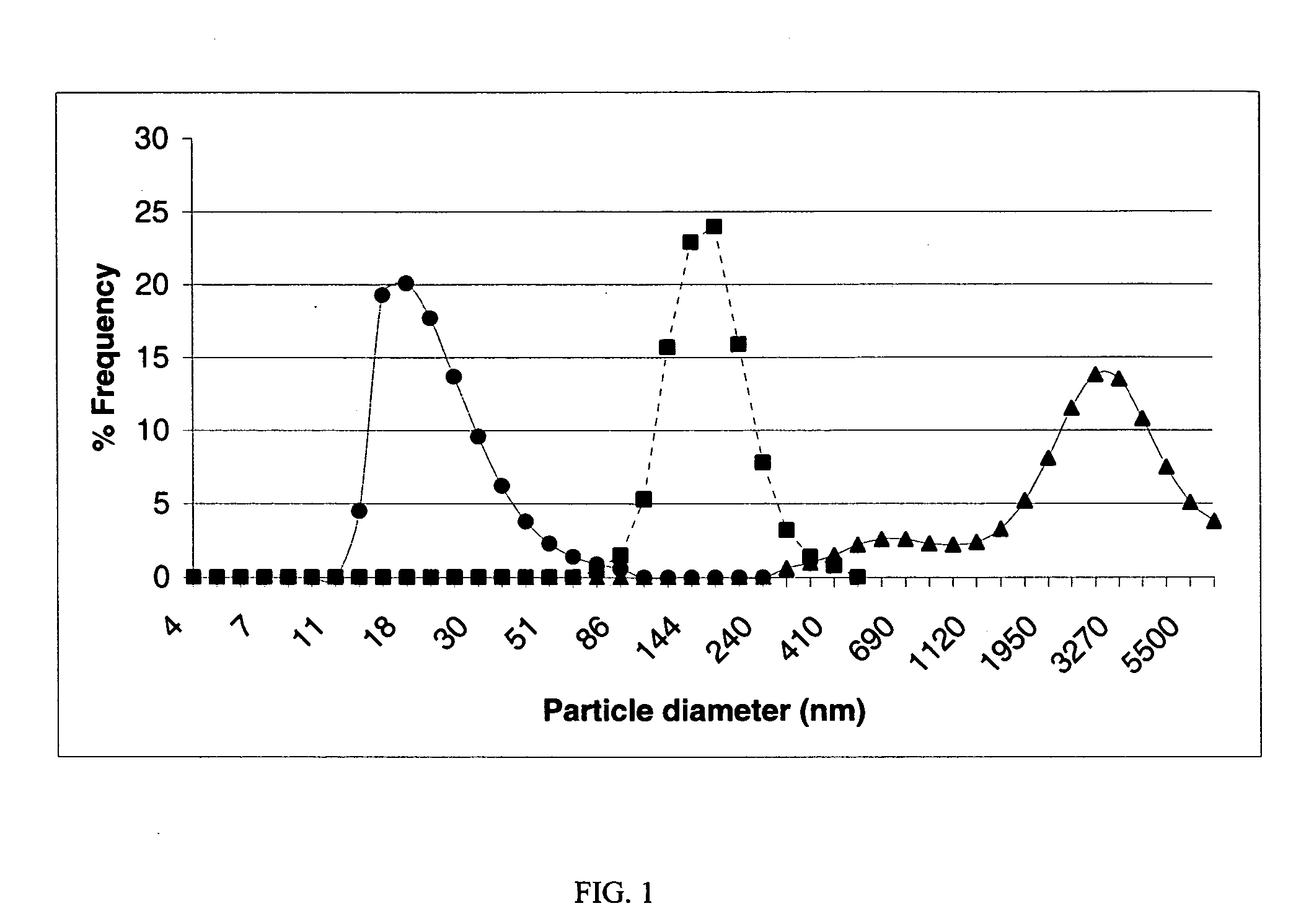Nanoparticulate anionic clays
a technology of anionic clay and nanoparticulate, which is applied in the direction of colloidal chemistry, physical/chemical process catalysts, other chemical processes, etc., can solve the problems of not being able to determine the size and colloidal stability of the resulting product, not being able to carry out and produce products, and not being able to determine the particle size and colloidal stability of the resultant produ
- Summary
- Abstract
- Description
- Claims
- Application Information
AI Technical Summary
Benefits of technology
Problems solved by technology
Method used
Image
Examples
examples
Measurement of Particle Size
[0021] The volume-weighted, mean particle size diameters of anionic clay dispersions obtained in the following examples were measured by a dynamic light scattering method using a MICROTRAC® Ultrafine Particle Analyzer (UPA) Model 150 from Leeds & Northrop. The analysis provides percentile data that show the percentage of the volume of the particles that is smaller than the indicated size. The 50 percentile is known as the median diameter, which is referred herein as median particle size. The volume-weighted mean particle size diameter is calculated from the area distribution of the particle size as described in the MICROTRAC® Ultrafine Particle Analyzer (UPA) Model 150 manual. The standard deviation describes the width of the particle size distribution. The smaller the standard deviation the narrower the width of the distribution.
examples 1-3
Preparation of Nanoparticulate Anionic Clays, Materials and Methods
[0022] MgCl2:6H2O and AlCl3:6H2O and NaOH were purchased from Aldrich Chemical Company. Solutions were prepared using pure distilled water. A highly efficient prop-like mixing apparatus of the type described in Research Disclosure, Vol. 382, February 1996, Item 38213, was employed to prepare nanoparticulate colloids. Solutions were introduced into a zone of high shear mixing via calibrated peristaltic pumps at known flow rates. The mixing efficiencies and flow rates were varied to obtain stable nanoparticle colloidal dispersions. The mixing efficiency of the apparatus is described by the turnover rate, where the turnover rate=(stir rate(rev / min)×turnover volume (ml / rev)) divided by the aqueous volume. The mixing efficiency typically was kept constant for each example and was about 25 turnovers / min, or 0.4 turnovers / sec.
example 1
[0023] Into a 1.0 L vessel containing 200 ml of distilled water which was stirred with a prop-like stirrer at a rate of 2000 rpm was simultaneously added, 100.0 ml of a 1.0 M MgCl2:6H2O solution at 10 ml per minute for 10 minutes; 100.0 ml of a 0.5 M AlCl3:6H2O solution at 10 ml per minute for 10 minutes; and a 2.5 M NaOH solution at a rate sufficient to keep the pH of the reaction mixture between 8.5-9.0. The addition rate of 2.5 NaOH varied slightly between about 11 and 12 ml / min. After the addition was completed, the dispersion was then washed free of salt by dialfiltration, until the ionic conductivity of the dispersion was less than about 0.2 mS. The resulting dispersion had a mean particle size diameter of 134 nm with a standard deviation of 39 nm, and did not settle after standing three weeks indicating that the dispersion was a stable colloid. The percent solids of the final dispersion was 3.5% by weight. The particle size distribution parameters are given in Table 1. The pa...
PUM
| Property | Measurement | Unit |
|---|---|---|
| particle size diameter | aaaaa | aaaaa |
| particle size diameter | aaaaa | aaaaa |
| particle size diameter | aaaaa | aaaaa |
Abstract
Description
Claims
Application Information
 Login to View More
Login to View More - R&D
- Intellectual Property
- Life Sciences
- Materials
- Tech Scout
- Unparalleled Data Quality
- Higher Quality Content
- 60% Fewer Hallucinations
Browse by: Latest US Patents, China's latest patents, Technical Efficacy Thesaurus, Application Domain, Technology Topic, Popular Technical Reports.
© 2025 PatSnap. All rights reserved.Legal|Privacy policy|Modern Slavery Act Transparency Statement|Sitemap|About US| Contact US: help@patsnap.com

